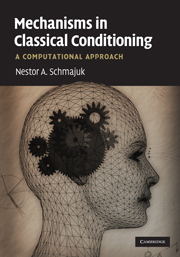Book contents
- Frontmatter
- Contents
- Preface
- Acknowledgments
- Abbreviations
- Part I Introduction
- Part II Attentional and associative mechanisms
- 2 An attentional–associative model of conditioning
- 3 Simple and compound conditioning
- 4 The neurobiology of fear conditioning
- 5 Latent inhibition
- 6 The neurobiology of latent inhibition
- 7 Creativity
- 8 Overshadowing and blocking
- 9 Extinction
- 10 The neurobiology of extinction
- Part III Configural mechanisms
- Part IV Attentional, associative, configural and timing mechanisms
- Part V Conclusion: mechanisms of classical conditioning
- References
- Author Index
- Subject Index
3 - Simple and compound conditioning
from Part II - Attentional and associative mechanisms
Published online by Cambridge University Press: 23 May 2010
- Frontmatter
- Contents
- Preface
- Acknowledgments
- Abbreviations
- Part I Introduction
- Part II Attentional and associative mechanisms
- 2 An attentional–associative model of conditioning
- 3 Simple and compound conditioning
- 4 The neurobiology of fear conditioning
- 5 Latent inhibition
- 6 The neurobiology of latent inhibition
- 7 Creativity
- 8 Overshadowing and blocking
- 9 Extinction
- 10 The neurobiology of extinction
- Part III Configural mechanisms
- Part IV Attentional, associative, configural and timing mechanisms
- Part V Conclusion: mechanisms of classical conditioning
- References
- Author Index
- Subject Index
Summary
We have previously shown (Schmajuk, 1997), that the SLG model addresses different basic conditioning paradigms, including (a) simultaneous, delay and trace conditioning, and the effect of varying the interstimulus interval (Smith, 1968); (b) the effect of increasing US duration (Burkhardt & Ayres, 1978); (c) backward conditioning (Siegel & Domjan, 1971; Heith & Rescorla, 1973); (d) second-order excitatory (Kamil, 1969) and inhibitory conditioning (Rescorla, 1976); (e) sensory preconditioning (Brogden, 1939); and (f) partial reinforcement with different percentages of reinforced trials (Gormezano & Moore, 1969). According to the model, interstimulus interval (ISI, see Figure 2.3) effects are explained in terms of the shape of the trace τCS (see Figure 2.3 and Equation [2.1]), the effect of increasing US duration in terms of the increase in the size of the temporal overlap between XCS and λUS (see Equation [2.9a]), backward conditioning in terms of the combination (chaining) of CS–CX and CX–US associations (see Equation [2.3]), second-order conditioning and sensory preconditioning in terms of the combination (chaining) of CS1–CS2 and CS2–US associations. The model correctly describes the competition between the excitation due to chaining and the conditioned inhibition (see below), produced by the alternated presentations of CS–CX (or CS1–CS2) and CX–US (or CS2–US) trials, present in backward conditioning, second-order conditioning and sensory preconditioning.
Recent simulations show that the SLG model also describes the effect of massed vs. spaced trials (e.g. Spence & Norris, 1950) in terms of the increased CX–US associations (that compete with CS–US associations) when massed trials are used.
Information
- Type
- Chapter
- Information
- Mechanisms in Classical ConditioningA Computational Approach, pp. 34 - 56Publisher: Cambridge University PressPrint publication year: 2010
